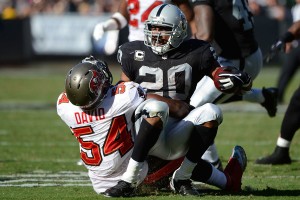Some Notable Football Ankle Injuries, Then And Now
 Professional football is one of the highest-satisfaction professions, as nine out of ten former athletes say they are glad they played the game. But fewer than half these men would want their children to participate in the sport, due to the frequency and severity of the injury. 90 percent of former players suffered at least one major injury during their careers, typically to their ankle, knee, hip, or foot.
Professional football is one of the highest-satisfaction professions, as nine out of ten former athletes say they are glad they played the game. But fewer than half these men would want their children to participate in the sport, due to the frequency and severity of the injury. 90 percent of former players suffered at least one major injury during their careers, typically to their ankle, knee, hip, or foot.
To get back on the field faster, many injured football players wear orthotic braces over their injured joint. These devices are not the cumbersome braces they were just a few years ago. Instead, most braces are very lightweight yet also very strong. For example, ankle braces for running can fit snugly without inhibiting a runner’s motion, providing support and stabilization to the vulnerable joint, and helping to absorb the shock of the foot’s impact with the ground.
Don’t miss these notable ankle injuries:
Jerry Kramer, 1961 Green Bay Packers
Both before and after Kramer strained several ligaments in his left ankle during the championship game against the Minnesota Vikings, he was known as one of the toughest football players of his or any era.
As a youth in the 1950s, Kramer lost a fist-size chunk of his right side during a high school workshop incident and he was accidentally shot in the arm with a double-barrel shotgun. In college, doctors left a large, zipper-style scar on his neck after they removed a chipped vertebra.
After joining the Packers in 1958, Kramer detached his retina during a game against the Los Angeles Rams in 1960. Four years later, he missed an entire season after surgery to remove four large wooden splinters that were lodged in his groin near his spine from a 1953 calf-chasing incident.
Kramer’s shining moment may have been in the 1967 Ice Bowl when he cleared the way for quarterback Bart Starr’s last-minute touchdown sneak by going low on Dallas Cowboys defender Jethro Pugh. Many have called it the greatest block in NFL history, but old-timers in Dallas sharply disagree. They claim that Kramer was offsides on the play, and if you slow this video way down, it does appear that he may have moved a hair early. Then again, maybe he just got off the ball a fraction of a second before everyone else, which would help explain why Number 64 is remembered as one of the game’s all-time greats.
Darren McFadden, 2012 Oakland Raiders
The NFL game was a lot different in the 1960s. Back then, in an era not too far removed from the Four Horsemen and the Flying Wedge, contests largely pitted force against force, and so many ankle and other injuries occurred because of excess weight and leverage on these rather vulnerable joints.
But today, the emphasis is on speed and agility, largely because today’s players are so big and strong that they would probably seriously hurt one another in one of those old-time slugfests. That brings this blog to the dreaded and feared high ankle sprain and one of its most prominent poster boys.
Today, most ankle sprains occur because of excess force applied to the ligaments. If this outside trauma affects the syndesmotic ligaments which connect the tibia and fibula, the injury is a “high” ankle sprain. Even a minor Grade 1 sprain, in which none of the ligaments are torn, normally sidelines the player for several weeks, because a syndesmotic injury is a weight-bearing injury that makes it difficult or impossible to walk or plant on the injured ankle.
McFadden was actually lucky in this instance. A Grade 3 ankle sprain usually just means an additional week or three of inactivity, but to correct a Grade 3 high ankle sprain, doctors must perform surgery to reconnect the two bones and repair the torn ligaments.
Different ankle injuries plague different players of different generations.